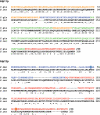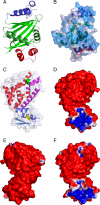Chaperones of F1-ATPase
- PMID: 19383603
- PMCID: PMC2719352
- DOI: 10.1074/jbc.M109.002568
Chaperones of F1-ATPase
Abstract
Mitochondrial F(1)-ATPase contains a hexamer of alternating alpha and beta subunits. The assembly of this structure requires two specialized chaperones, Atp11p and Atp12p, that bind transiently to beta and alpha. In the absence of Atp11p and Atp12p, the hexamer is not formed, and alpha and beta precipitate as large insoluble aggregates. An early model for the mechanism of chaperone-mediated F(1) assembly (Wang, Z. G., Sheluho, D., Gatti, D. L., and Ackerman, S. H. (2000) EMBO J. 19, 1486-1493) hypothesized that the chaperones themselves look very much like the alpha and beta subunits, and proposed an exchange of Atp11p for alpha and of Atp12p for beta; the driving force for the exchange was expected to be a higher affinity of alpha and beta for each other than for the respective chaperone partners. One important feature of this model was the prediction that as long as Atp11p is bound to beta and Atp12p is bound to alpha, the two F(1) subunits cannot interact at either the catalytic site or the noncatalytic site interface. Here we present the structures of Atp11p from Candida glabrata and Atp12p from Paracoccus denitrificans, and we show that some features of the Wang model are correct, namely that binding of the chaperones to alpha and beta prevents further interactions between these F(1) subunits. However, Atp11p and Atp12p do not resemble alpha or beta, and it is instead the F(1) gamma subunit that initiates the release of the chaperones from alpha and beta and their further assembly into the mature complex.
Figures







Similar articles
-
Atp11p and Atp12p are chaperones for F(1)-ATPase biogenesis in mitochondria.Biochim Biophys Acta. 2002 Sep 10;1555(1-3):101-5. doi: 10.1016/s0005-2728(02)00262-1. Biochim Biophys Acta. 2002. PMID: 12206899
-
Atp11p and Atp12p are assembly factors for the F(1)-ATPase in human mitochondria.J Biol Chem. 2001 Aug 17;276(33):30773-8. doi: 10.1074/jbc.M104133200. Epub 2001 Jun 15. J Biol Chem. 2001. PMID: 11410595
-
An accessible hydrophobic surface is a key element of the molecular chaperone action of Atp11p.J Biol Chem. 2001 Oct 26;276(43):39945-9. doi: 10.1074/jbc.M107252200. Epub 2001 Aug 24. J Biol Chem. 2001. PMID: 11522798
-
Structures and interactions of proteins involved in the coupling function of the protonmotive F(o)F(1)-ATP synthase.Curr Protein Pept Sci. 2002 Aug;3(4):451-60. doi: 10.2174/1389203023380558. Curr Protein Pept Sci. 2002. PMID: 12370007 Review.
-
Unidirectional regulation of the F1FO-ATP synthase nanomotor by the ζ pawl-ratchet inhibitor protein of Paracoccus denitrificans and related α-proteobacteria.Biochim Biophys Acta Bioenerg. 2018 Sep;1859(9):762-774. doi: 10.1016/j.bbabio.2018.06.005. Epub 2018 Jun 8. Biochim Biophys Acta Bioenerg. 2018. PMID: 29886048 Review.
Cited by
-
Expression of mammalian mitochondrial F1-ATPase in Escherichia coli depends on two chaperone factors, AF1 and AF2.FEBS Open Bio. 2016 Oct 25;6(12):1267-1272. doi: 10.1002/2211-5463.12143. eCollection 2016 Dec. FEBS Open Bio. 2016. PMID: 28203526 Free PMC article.
-
F-Type ATP Synthase Assembly Factors Atp11 and Atp12 in Arabidopsis.Front Plant Sci. 2020 Oct 19;11:522753. doi: 10.3389/fpls.2020.522753. eCollection 2020. Front Plant Sci. 2020. PMID: 33193469 Free PMC article.
-
C1-FDX is required for the assembly of mitochondrial complex I and subcomplexes of complex V in Arabidopsis.PLoS Genet. 2024 Oct 2;20(10):e1011419. doi: 10.1371/journal.pgen.1011419. eCollection 2024 Oct. PLoS Genet. 2024. PMID: 39356718 Free PMC article.
-
Hsp90 and mitochondrial proteases Yme1 and Yta10/12 participate in ATP synthase assembly in Saccharomyces cerevisiae.Mitochondrion. 2011 Jul;11(4):587-600. doi: 10.1016/j.mito.2011.03.008. Epub 2011 Mar 23. Mitochondrion. 2011. PMID: 21439406 Free PMC article.
-
Blackout in the powerhouse: clinical phenotypes associated with defects in the assembly of OXPHOS complexes and the mitoribosome.Biochem J. 2020 Nov 13;477(21):4085-4132. doi: 10.1042/BCJ20190767. Biochem J. 2020. PMID: 33151299 Free PMC article. Review.
References
Publication types
MeSH terms
Substances
Associated data
- Actions
- Actions
- Actions
- Actions
Grants and funding
LinkOut - more resources
Full Text Sources

